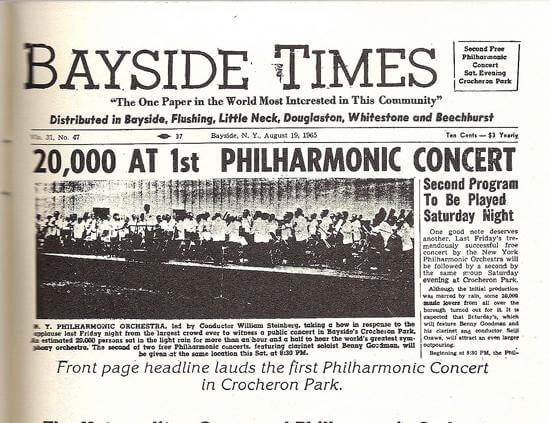By Joan Brown Wettingfeld
The idea of tracing the history of Crocheron Park in Bayside occurred to me recently and turned out to be more challenging than one might imagine. It has, however, interesting connections to our city’s history. Research revealed the origin of its name, for it was constructed on land owned by the Crocheron family, whose history dates back to the 17th century.
Reference is made to John Crocheron in his will recorded on Sept. 3, 1696, the year he died. He had a wife, Mary, and two sons, Nicholas and Anthony, which is recorded in a “History of Richmond County, New York, 1887,” indicating the family originated in Staten Island.
The family history notes that John Crocheron and his family lived on the edge of Little Neck Bay on the land that became Crocheron Park. At that time, he farmed the land, some of which later belonged to the estate of John Golden. Many generations of the Crocheron family were to live there by the bay.
John Crocheron had a long line of distinguished descendents, including Henry Crocheron, who served in Congress from 1815−17, and Nicholas Crocheron, a member of the 1854 state Assembly.
Another descendent was Joe Crocheron, a racing enthusiast said to be “as renowned as Cornelius Vanderbuilt and August Belmont.”
In the mid− and late 19th century (1866−71), when the notorious William “Boss” Tweed ruled the city’s government, the Crocheron House Hotel near the shores of Little Neck Bay became known as a favorite gathering place for Tammany Hall events, such as clambakes and picnics.
It was, therefore, no coincidence that the infamous Tweed was well−versed in the advantages of the shoreline of Bayside, as well. It was useful knowledge when he was held on charges of corruption and took refuge from the Crocheron House Hotel after he escaped from the Ludlow Street jail in 1875.
Through his numerous connections he was able to escape and landed in Spain. My sources and others mention Crocheron House and or the Garrison Hotel at Willets Point, two of Tweed’s favorite haunts, as possibilities for where his flight to Spain started. Other places have also been suggested.
To make a long story short, he was arrested by the Spanish police and returned to prison in New York. Two years later, in 1878, he died in his prison cell.
The old Crocheron Hotel burned down in 1908 and the estate land lay undeveloped until the city bought the land it once stood on. Another 45 acres were purchased by the city at the request of the Bayside Civic Association. Plans for a park were drawn up for two areas to be consolidated into a park.
By 1936, the park was now a reality, with picnic grounds, winding paths, a winter skating pond and thousands of trees. Later a playground and tennis courts were followed by a baseball diamond and field house. Visitors also enjoyed views of the bay from the bluff where the gazebo was located.
In 1954, the city Parks Department bought the property that belonged to Broadway producer John Golden and built a park named in his honor, providing the Bayside neighborhood with another substantial and beautiful area for recreation and relaxation.
In the early 1960s, my father, Joseph H. Brown, founded the Bayside Historical Society, which soon sponsored summer outdoor concerts by the Metropolitan Opera and the New York Philharmonic at Crocheron Park, attracting an unbelievable crowd of 20,000 people at the latter event.
Joan Brown Wettingfeld is a historian and freelance writer.




































